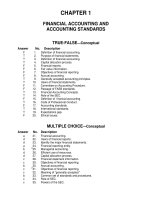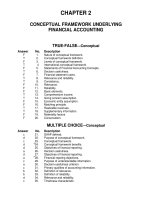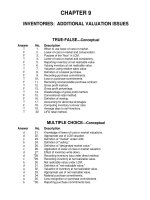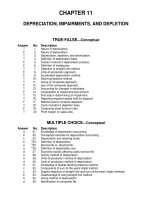Intermediate accounting 16e by kieso slide ch21
Bạn đang xem bản rút gọn của tài liệu. Xem và tải ngay bản đầy đủ của tài liệu tại đây (2.65 MB, 105 trang )
21-1
PREVIEW OF CHAPTER 21
Intermediate Accounting
16th Edition
Kieso ● Weygandt ● Warfield
21-2
21
Accounting for Leases
LEARNING OBJECTIVES
After studying this chapter, you should be able to:
1
Explain the nature, economic substance, and
advantages of lease transactions.
2
21-3
Describe the accounting for leases by lessees.
3
Describe the accounting for leases by lessors.
4
Describe the accounting and reporting for special
features of lease arrangements.
LO 1
THE LEASING ENVIRONMENT
A lease is a contractual agreement between a lessor and a lessee, that gives the lessee the right to use
specific property, owned by the lessor, for a specified period of time.
Largest group of leased equipment involves:
21-4
Information technology equipment
Transportation (trucks, aircraft, rail)
Construction
Agriculture
LO 1
ILLUSTRATION 21-2
What Do Companies Lease?
21-5
LO 1
THE LEASING ENVIRONMENT
Who Are the Players?
Captive Leasing
Banks
Independents
Companies
►
Wells Fargo
►
►
►
Chase
►
Citigroup
►
PNC
International Lease
Finance Corp.
Caterpillar Financial
Services Corp.
►
Ford Motor Credit (Ford)
►
IBM Global Financing
14%
55%
21-6
Market Share
31%
LO 1
THE LEASING ENVIRONMENT
Advantages of Leasing
21-7
1.
100% financing at fixed rates.
2.
Protection against obsolescence.
3.
Flexibility.
4.
Less costly financing.
5.
Tax advantages.
6.
Off-balance-sheet
financing.
LO 1
WHAT DO THE NUMBERS MEAN?
OFF-BALANCE-CHEET
FINANCING
WHAT’S YOUR
PRINCIPLE
As shown in our opening story, airlines use lease arrangements extensively. This results in a great deal of off-balance-sheet financing. The
following chart indicates that many airlines that lease aircraft understate debt levels by a substantial amount. Airlines are not the only ones
playing the off-balance-sheet game. A recent study estimates that for S&P 500 companies, off-balance-sheet lease obligations total more than
one-half trillion dollars, or roughly three percent of market value. Thus, analysts must adjust reported debt levels for the effects of noncapitalized leases.
A methodology for making this adjustment is
discussed in Eugene A. Imhoff, Jr., Robert C.
Lipe, and David W. Wright, “Operating Leases:
Impact of Constructive Capitalization,”
Accounting Horizons (March 1991).
Source: D. Zion and A. Varshney, “Leases Landing on Balance Sheets,” Credit Suisse Equity Research (August 17, 2010).
21-8
LO 1
THE LEASING ENVIRONMENT
Conceptual Nature of a Lease
Capitalize a lease that transfers substantially all of the benefits and risks of property ownership, provided the
lease is noncancelable.
Leases that do not transfer substantially all the benefits
and risks of ownership are operating
leases.
21-9
LO 1
21
Accounting for Leases
LEARNING OBJECTIVES
After studying this chapter, you should be able to:
1
Explain the nature, economic substance, and
advantages of lease transactions.
2
21-10
Describe the accounting for leases by lessees.
3
Describe the accounting for leases by lessors.
4
Describe the accounting and reporting for special
features of lease arrangements.
LO 2
ACCOUNTING BY THE LESSEE
If the lessee capitalizes a lease, the lessee records an asset and a liability generally equal to the present
value of the rental payments.
Records depreciation on the leased asset.
Treats the lease payments as consisting of interest and principal.
Journal Entries for Capitalized Lease
21-11
ILLUSTRATION 21-2
LO 2
ACCOUNTING BY THE LESSEE
For a capital lease, the FASB has identified four criteria.
1.
Lease transfers ownership of the property to the lessee.
2.
Lease contains a bargain-purchase option.
3.
Lease term is equal to 75 percent or more of the estimated economic life of the leased property.
4.
The present value of the minimum lease payments (excluding
executory costs) equals or exceeds 90 percent of the fair value of the
One or more must be
met for capital lease
accounting.
leased property.
21-12
LO 2
ACCOUNTING BY THE LESSEE
Lease Agreement
Leases that DO NOT meet any of the four
criteria are accounted for as Operating Leases.
ILLUSTRATION 21-4
Diagram of Lessee’s Criteria for Lease Classification
21-13
LO 2
ACCOUNTING BY THE LESSEE
Capitalization Criteria
Transfer of Ownership Test
If the lease transfers ownership of the asset to the lessee, it is a capital lease.
Bargain-Purchase Option Test
At the inception of the lease, the difference between the option price and the expected fair
market value must be large enough to make exercise of the option reasonably assured.
21-14
LO 2
ACCOUNTING BY THE LESSEE
Capitalization Criteria
Economic Life Test (75% Test)
Lease term is generally considered to be the fixed, noncancelable term of the lease.
Bargain-renewal option can extend this period.
At the inception of the lease, the difference between the renewal rental and the expected fair
rental must be great enough to make exercise of the option to renew reasonably assured.
21-15
LO 2
ACCOUNTING BY THE LESSEE
Illustration: Home Depot leases Dell PCs for two years at a rental of $100 per month per computer
and subsequently can lease them for $10 per month per computer for another two years. The lease
clearly offers a bargain-renewal option; the lease term is considered to be four years.
21-16
LO 2
ACCOUNTING BY THE LESSEE
Capitalization Criteria
Recovery of Investment Test (90% Test)
Minimum Lease Payments:
Minimum rental payment
Guaranteed residual value
Penalty for failure to renew or extend the lease
Bargain-purchase option
Executory Costs:
21-17
Insurance
Exclude from present value of Minimum Lease Payment
Maintenance
Calculation
Taxes
LO 2
ACCOUNTING BY THE LESSEE
Capitalization Criteria
Discount Rate
Lessee computes the present value of the minimum lease payments using its incremental borrowing rate,
with one exception.
►
If the lessee knows the implicit interest rate computed by the lessor and it is less than the
lessee’s incremental borrowing rate, then lessee must use the lessor’s rate.
21-18
LO 2
ACCOUNTING BY THE LESSEE
Asset and Liability Accounted for Differently
Asset and Liability Recorded at the lower of:
21-19
1.
present value of the minimum lease payments (excluding executory costs) or
2.
fair-market value of the leased asset at the inception of the lease.
LO 2
ACCOUNTING BY THE LESSEE
Asset and Liability Accounted for Differently
Depreciation Period
21-20
If lease transfers ownership, depreciate asset over the economic life of the asset.
If lease does not transfer ownership, depreciate over the term of the lease.
LO 2
ACCOUNTING BY THE LESSEE
Asset and Liability Accounted for Differently
Effective-Interest Method
Used to allocate each lease payment between principal and interest.
Depreciation Concept
21-21
Depreciation and the discharge of the obligation are independent accounting processes.
LO 2
ACCOUNTING BY THE LESSEE
Illustration: Caterpillar Financial Services Corp. (a subsidiary of Caterpillar) and Sterling Construction Corp. sign a lease agreement dated January 1, 2017, that
calls for Caterpillar to lease a front-end loader to Sterling beginning January 1, 2017. The terms and provisions of the lease agreement, and other pertinent data,
are as follows.
•
The term of the lease is five years. The lease agreement is noncancelable, requiring equal rental payments of $25,981.62 at the beginning of each year
(annuity-due basis).
•
The loader has a fair value at the inception of the lease of $100,000, an estimated economic life of five years, and no residual value.
•
Sterling pays all of the executory costs directly to third parties except for the property taxes of $2,000 per year, which is included as part of its annual
payments to Caterpillar.
21-22
•
The lease contains no renewal options. The loader reverts to Caterpillar at the termination of the lease.
•
Sterling’s incremental borrowing rate is 11 percent per year.
•
Sterling depreciates, on a straight-line basis, similar equipment that it owns.
•
Caterpillar sets the annual rental to earn a rate of return on its investment of 10 percent per year; Sterling knows this fact.
LO 2
ACCOUNTING BY THE LESSEE
What type of lease is this?
Capital Lease?
Capitalization Criteria:
1.
Transfer of ownership
NO
2.
Bargain purchase option
NO
3.
Lease term = 75% of economic life of leased
property
4.
Lease term = 5 yrs.
Economic life = 5 yrs.
YES
Present value of minimum lease payments =>
90% of FMV of property
PV = $100,000 FMV = $100,000.
21-23
YES
LO 2
ACCOUNTING BY THE LESSEE
Compute present value of the minimum lease payments.
Payment
$ 25,981.62
Property taxes (executory cost)
-
Minimum lease payment
2,000.00
23,981.62
Present value factor (i=10%,n=5)
x
4.16986
PV of minimum lease payments
$100.000.00
*
Sterling uses Caterpillar’s implicit interest rate of 10 percent instead of its incremental borrowing rate of 11 percent because (1)
it is lower and (2) it knows about it.
* Present value of an annuity due of 1 for 5 periods at 10% (Table 6-5)
21-24
LO 2
ACCOUNTING BY THE LESSEE
Sterling records the capital lease on its books on January 1, 2017, as:
Leased Equipment (under capital leases) 100,000
Lease Liability
100,000
Sterling records the first lease payment on January 1, 2017, as follows.
Property Tax Expense
Lease Liability
Cash
21-25
2,000.00
23,981.62
25,981.62
LO 2









